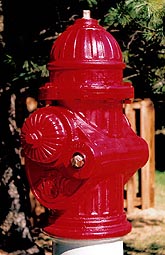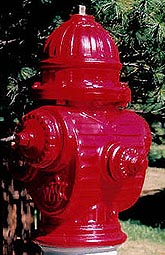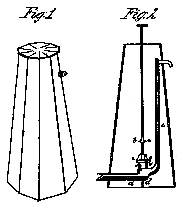 | Hydrant specifications for the city of Baltimore have been shaped by fire events, as well as improvements in fire fighting technology. Baltimore has been a testing ground for ideas, some of which have been useful, some of which have faded away. Amongst the earliest of the city's hydrants were those of the wooden cased variety. These consisted of an iron "faucet" encased in a wooden box in the shape of an multi-sided truncated pyramid. This illustration is from U.S. Patent #909, awarded in 1838 to John M. Jorden of Baltimore. His improvement was a drain for the hydrant's riser, which was intended to prevent freezing. |
| In 1870, James Curran, of Baltimore, was awarded U.S. Patent #99646 for a hydrant whose bonnet is a separate cover; the entire cover is lifted off to gain access to the hydrant's nozzles. The hydrant also had a frost jacket, designed to prevent stress to the hydrant's barrel due to frost heave. It is reported that this hydrant was specified in a twin steamer configuration, the steamer port having been developed around 1860. This was perhaps the first use of the twin steamer concept, later adopted by Chicago and other cities. Unfortunately, the Curran hydrant was known as a plumber's nightmare. After the great Baltimore fire of 1904, it was time to move onto an improved specification for the city. | ||
| At the lower left is one of the James Curran patent hydrants, from a photograph taken at the scene of the Great Baltimore Fire of 1904. Another period photo of the Curran hydrant can be seen in this advertisement for a hose shut-off. Far right: early Baltimore City Fire Department badge, showing the Curran hydrant. |
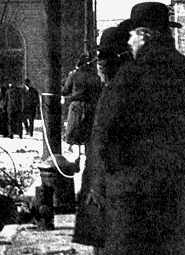 | 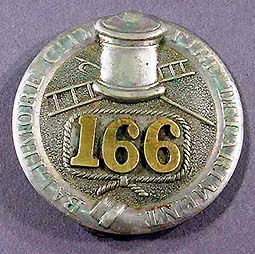 |
 |
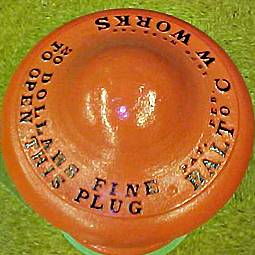 | Although apparently none of the Curran hydrants remain today, here is a restored cover from the hydrant which is on display at the Fire Museum of Maryland. "20 DOLLARS FINE |
| After the great fire a new specfication was drawn up by Arthur O. Babendreier (1870-1948) who worked for the city of Baltimore Water Department. He was a mechanical engineer by trade and also taught at Johns Hopkins University. Mr. Babendreier, an inventor, was awarded U.S. patent #734251 in 1903 for the hydrant, just prior to the Great Fire. |
| | Arthur O. Babendreier's signature |
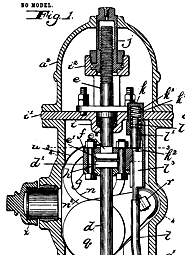 | U.S. Patent #734251 was issued to Arthur Babendreier on July 21 of the year 1903. |
| Babendreier's second hydrant is a simpler design. A few of these are also still in service as of the year 2001. |
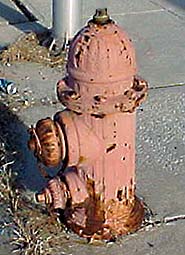
|
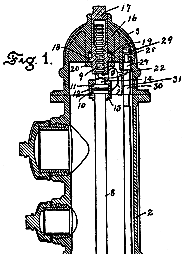
|
U.S. Patent #845505 was issued on February 26th of the year 1907 to Arthur Babendreier. |
|
Baltimore High Pressure Fire System "High pressure systems are important for a number of reasons. Conditions may exist where it may not be desirable to place fire engines in the fire zone such, as where buildings may collapse, shed bricks or cornices, etc. Conditions may exist where fire engines may not be able to get into close proximity of involved buildings due to traffic congestion or debris from an earthquake or collapsed building." "The high pressure system allows fire fighters to park where they can, and pack in their gear. Through use of Gleeson, Ross, or Vulcan valves they can "dial in" the desired pressure discharged from the high pressure system and most high pressure hydrants can supply from between four and six 2½ inch hose lines." --- Willis Lamm |
 | Between 1909 and 1915 a high pressure fire system was installed by the Pittsburgh Valve Foundry and Construction Co. of Pittsburgh, Pennsylvania. Depicted at left is the iron street cover for the hydrant. These were originally painted red, then, later, chrome yellow. There are exactly 104 stars on each cover. The text reads:
Balto. Fire Dept. |
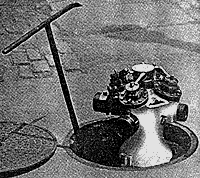 | The Baltimore High Pressure fire system utilized the Vulcan portable hydrant made by Ross Valve of Troy, NY. Here is the portable hydrant mounted for use, with the key for the mainvalve in place. Photo courtesy Ross Valve |
 |
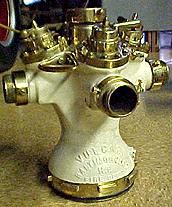 |
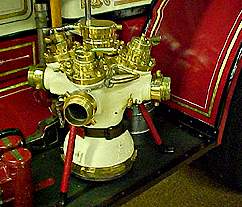
|
Here is the Vulcan portable hydrant on display at the Fire Museum of Maryland. The hydrant is constructed of bronze and weighs 110 pounds (50kg). Designed to handle up to 500psi, the 4 independent valves regulate pressure from 0 - 300psi to the four 2 1/2" hose outlets. |
|
The final chapter of the early Baltimore hydrant specifications concludes with a hydrant design by the great Denis O'brien of A.P. Smith Manufacturing Co. Denis O'brien designed the Model S, made famous by New York City, a timeless design still produced. For Baltimore, the swinging gate Babendreier hydrants proved to be unreliable in service, but the concept of gated double steamer outlets was still desired. The O'brien hydrant is more conventional in appearance, and uses a gate that is shared between both steamer outlets: either both outlets can be open, or one can be shut at any given time, but both cannot be shut. Unfortunately, the only gates that seem to hold up under time are screw types, such as the slide gates on Rensselaer and AWS high pressure multi-valve hydrants, or the externally mounted hose gate valves which are still sold today. |
| The Baltimore spec hydrant designed by Denis O'brien resembles the Model S, one of the most successful hydrant designs of all time. The operating nut for the nozzle gate valve can be seen between the twin pumper outlets. | 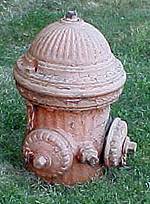 | 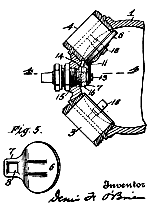 | U.S. Patent #1553953 was awarded to Denis O'brien of East Orange, NJ, on September 15th of 1925 |
|
|
|
|
| Unless otherwise noted, all contents of these WWW pages © FireHydrant.org |
